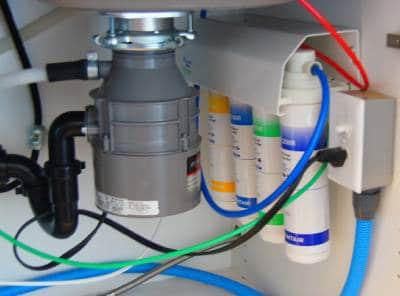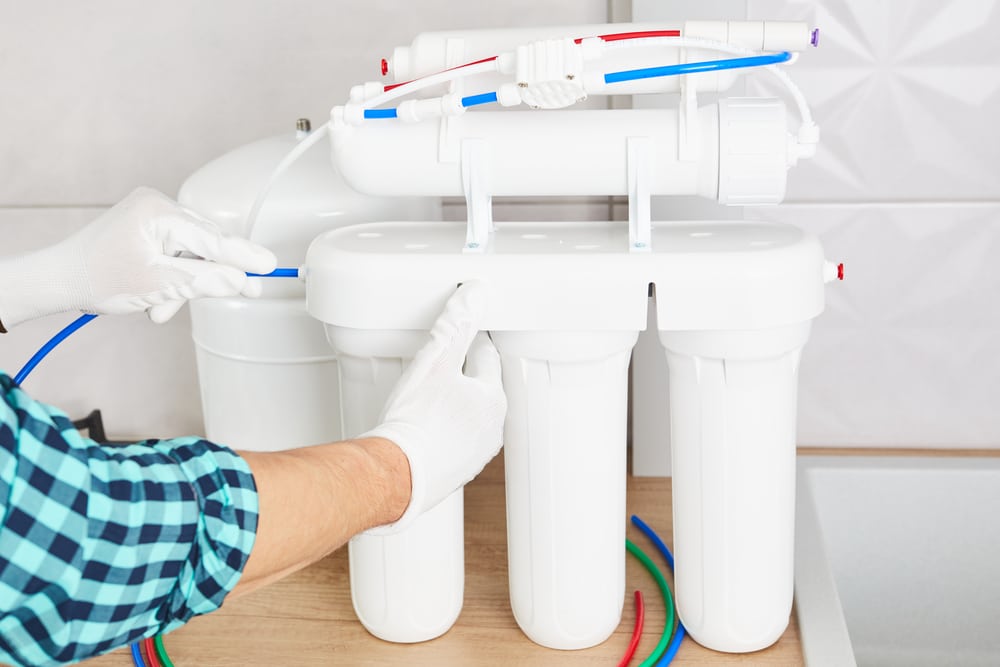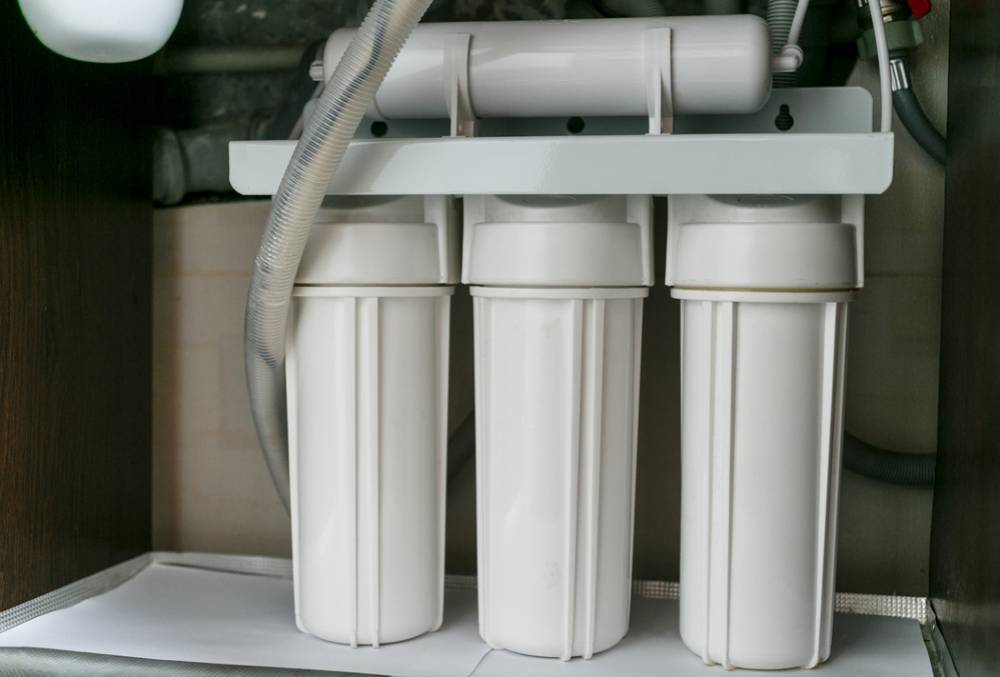Have you ever wondered ‘how does an under sink water filter work?’
If used correctly, these simple and reliable water treatment systems can transform your home water supply in no time. With an under sink water filter, you get great-tasting water with fewer contaminants, but you can also benefit from reduced issues caused by hard water.
Under sink water filters are generally unobtrusive and budget-friendly. Once you have one of these devices installed, it’s easy to forget all about them. They work silently in the background, eliminating the need for endless pitchers to help create filtered water.
Today, we will look at everything you need to know about under sink filters and how they work to make your water more appealing. If you’ve ever considered investing more into under sink water filtration systems to help improve your tap water quality, this is the guide for you.
Under Sink Water Filters Explained
An under-sink filter is just what it sounds like. These simple tools are designed to create filtered water out of tap water without using special water pitchers. An under sink water filter can come in various shapes and forms, from the carbon block filter to tools using reverse osmosis to enhance the quality of your water.
A sink water filter system aims to improve the overall quality of water in your home while it’s still moving through the plumbing system. This reduces the amount of work you need to do to filter water after you retrieve it from the tap on your kitchen sink.
Most under sink filtration unit options are point of unit (POU) devices that work to remove the various kinds of contaminants we usually see in drinking water. POU means installing the system wherever you need to access clean water, such as in the kitchen or bathroom faucet. You can also access water filters that connect directly to your water line. However, these are whole house filters rather than under sink water filters.
An under sink water filter focuses specifically on a filter for one dedicated faucet.
How Does an Under Sink Water Filter Work?
Under sink water filters come in a variety of different designs, and their functionality is largely dependent on what kind of water filter you choose. A standard house water filtration system will usually access your water supply from a flexible hose that connects directly to the cold water line under your sink. This tube will divert some of your water through a specific ceramic filter, activated carbon filter, or another kind of filtration system.
The water leaves the filter through a separate plastic tube and can be delivered through a sink’s dedicated faucet, mounted onto the sink, so it’s not mixing with any unfiltered water. The constant pressure on the system means the water only flows from a filter when you turn on the faucet. You can even access a specialist faucet specifically for when you want to access filter water.
Alternatively, you can access water filter systems that cover the whole house at once. Whole house water filters don’t connect to a specific faucet but instead filter all of the water moving through your home, removing any dissolved inorganic solids and other contaminants.
A whole house water filter can require more work to install, but it can be particularly useful if you want to filter your entire cold water supply at once. This filtration method can also act as a water softener, depending on the kind of filtration. This reduces the impact of potential hard water sources on your plumbing.
What Are the Benefits of Under Counter Filters?

Under sink water filters are convenient and efficient ways for homeowners to gain access to filtered water. Your sink water filters can act as mini filtration systems, using a specialist sediment filter to remove anything unwanted from your tap water without special jugs.
An under sink water filtration system doesn’t require a lot of expensive installation in most cases, and it’s great for tackling both hot water and cold water in some cases. All you really need to do is make sure you stock up on replacement filters when you need them and empty anything out of the sediment filter or storage tank when necessary.
However, it’s worth noting that an under sink filtration system generally won’t accomplish all the results of other filtration systems. If you want extra cold water, an under-counter filter won’t give you the same benefits as a filtration system in your fridge. You’ll also have less space under your sink to store other items from around the kitchen.
That said, here are some benefits of under counter water filters.
Provide Targeted Filtration
If you want to avoid wasting money on activated carbon filtration for your whole house, an under sink water filtration system could be more cost-effective than most whole-house systems. Most families are only concerned with ensuring their drinking water is properly filtered.
Are Easy to Install
It’s usually relatively easy to install and maintain an under counter water filter compared to a whole house filtration system. The solution is also just as effective at sediment reduction as a whole house filter; you just target a specific faucet.
Great Speed
A counter water filter can be an excellent solution if you want to access great water from your filter’s faucet in no time. There’s less work required from the system than with a full home system, and you don’t need to replace the filters as often.
Save Money
You can save money on things like water pitcher filters because you’ll be able to access better water directly from your sink filter. You can even reduce cash spent on bottled water with better quality water at home.
Do Under Sink Water Filters Need Electricity?
Electricity can increase the cost of running your water softening or filtration system. While sometimes, an under sink system will require electricity, different kinds of filtration solutions can run without electricity.
Electric water filtration systems include options like reverse osmosis filters, which can be applied to both a single tap and a whole house filtering system. These tools reduce water pressure and minimise heavy metals in your water. The RO removes dissolved solids through a reverse osmosis membrane, killing harmful contaminants and reducing hard water.
Alternatively, a standard activated carbon system for cold and hot water can achieve things like hydrogen sulfide odour reduction and make your drinking water taste better without the need for an electrical connection.
Activated carbon under sink water filter systems are usually the most popular sink filters for those who don’t want to rely on electricity. However, while these substances reduce a range of unwanted components in your water, they do not remove dissolved solids, which are responsible for making water harder and saltier.
If you want a softening system for your water and access to water filtration, you’ll need to look into water filters that leverage electricity.
What Is Reverse Osmosis Filtration?
Reverse osmosis systems are just one of the many under sink filters you can consider improving the water quality in your home. As mentioned above, these types of under sink water filters are reliant on electricity to work. You’ll need to connect the under sink filters to your electrical line (usually by plugging them into an outlet) and plumb them into your sink.
Reverse osmosis removes all kinds of substances from feed water and unfiltered water when a build-up of pressure forces that liquid through a special kind of membrane. Water will spill from the concentrated side connected to your water line through to the less concentrated side to create freshwater.
The semipermeable membrane in reverse osmosis under sink filters has special pores that block contaminants, similar to many water filters. However, reverse osmosis systems are more capable of removing substances other sink filters can’t control. You don’t just get better drinking water with an RO system; you also get softer water.
Hard water is often the cause of numerous problems with household plumbing, causing everything from limescale to pipe damage.
How Does Under Sink Reverse Osmosis Work?
Reverse osmosis water filters are different from your standard system for filtered water. Both tools work by removing sediment and chlorine (among other substances) from water using a pre-filter before the water is forced through a semipermeable membrane to remove solids.
After water exits the reverse osmosis membrane in a filtration system, it passes through something called a ‘post filter’, which helps to further enhance drinking water before it reaches a dedicated faucet. RO or reverse osmosis systems can assist with enhancing your cold water supply, but they also work as a water softening system.
Like the carbon filter in an activated carbon system, the RO membrane is the focal point of the reverse osmosis strategy. However, The RO system also includes other kinds of mechanical filtration. Every solution comes with a sediment filter and carbon filter alongside the RO membrane, used as either pre-filters or post-filters.
When water enters an RO system, it passes through a pre-filtration system. The sink water flows through the pre-filtration active carbon filter to remove sediment and chlorine, which could clog or damage the RO membrane. The water then passes through the reverse osmosis membrane, where all kinds of microscopic particles are removed.
Finally, the water flows through to the storage tank, where it can be held until needed. The system continues to filter until the water tank is full before shutting off. This helps to improve the efficiency of your cold water supply.
Who Needs a Sink Water Filter?

Knowing how an under sink water filter works can be a useful first step in deciding whether you want to access a filtration system for your own house.
Water filtration systems can have benefits to offer a wide range of households. If you’re sick of worrying about the extra substances in your water, or you don’t always like the taste of your tap water, an under sink filtration system could be the perfect solution. You shouldn’t have to worry about filter replacement too often, and even when you need to change things up, filter cartridges are usually quite affordable.
Although an under sink filtration system won’t tackle the process of improving the water in your entire household, it can enhance your water in the area that matters most. This also means you don’t have to spend as much money on filter cartridges because you’re only filtering water in one place.
If you decide to get an under-sink filter system, you will need to think about what kind of filtration strategy is right for you. While a carbon filter can remove many contaminants, it won’t soften your water in the same way as a reverse osmosis filter. However, most people prefer to invest in full reverse osmosis filters only when they want to remove the hardness in the water throughout their entire house. Softening your water won’t help your pipes much if you’re only doing it for one dedicated faucet.
Will You Install an Under Sink Water Filter?
Remember, no matter which filtration strategy you choose, it’s usually a good idea to speak to a professional about your installation, particularly if you need to leverage electricity for your filter like you would with a standard reverse osmosis system.
What do you think? Are you planning to get an under sink water filter? Let us know in the comments below.
Additional Resources
- How to Make Tomato Soup in a Soup Maker
- How to Use Dough Hooks on a Hand Mixer
- How Much Ground Coffee per Cup
- How to Use a Mini Oven
Tom is a former chef turned full-time food blogger. He has always been passionate about food, and loves nothing more than experimenting in the kitchen and sharing his recipes with others. Tom’s blog is one of the most popular food blogs on the internet, and he has won numerous awards for his cooking. When he’s not blogging or cooking, Tom enjoys spending time with his wife and two young children.

